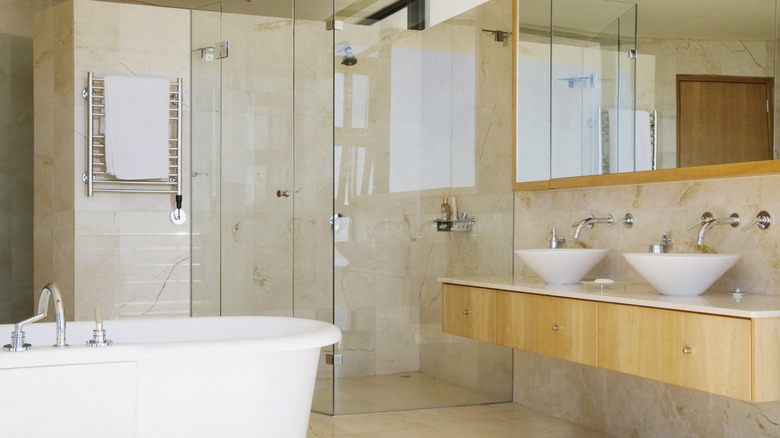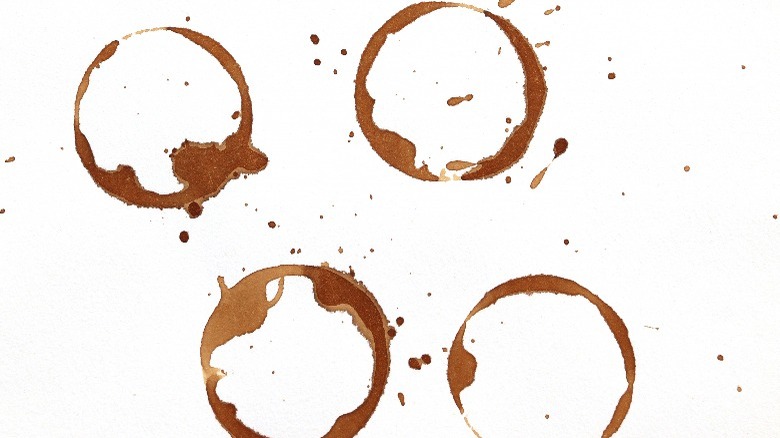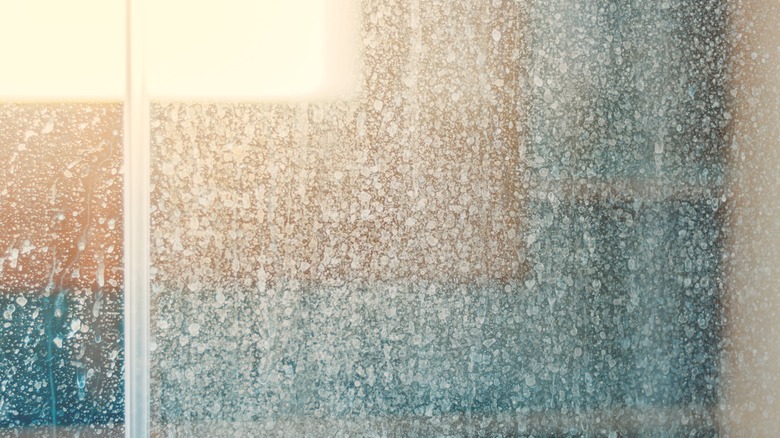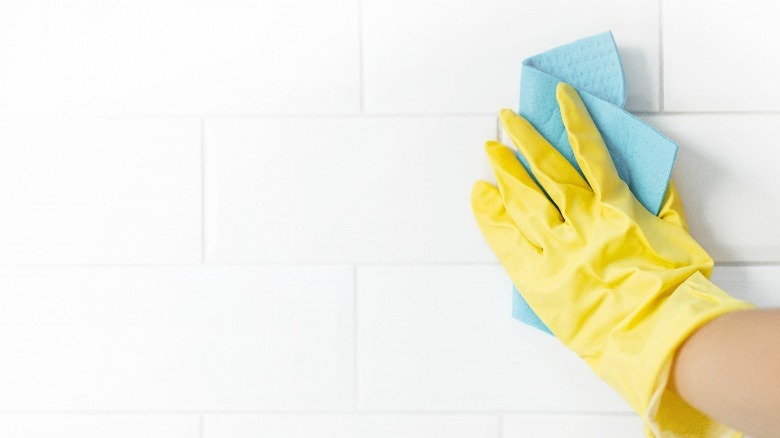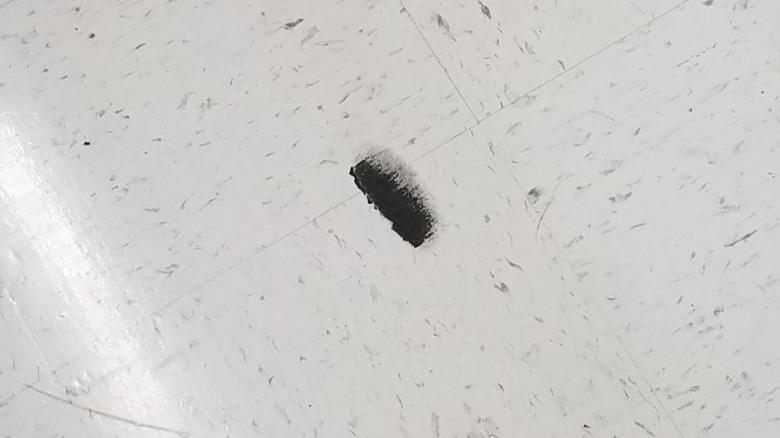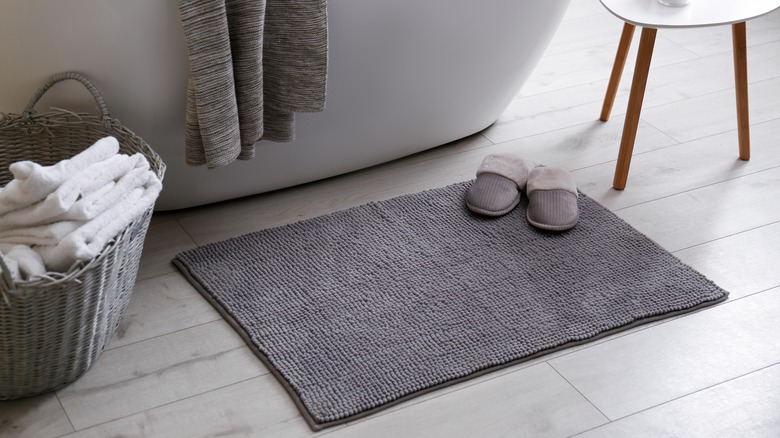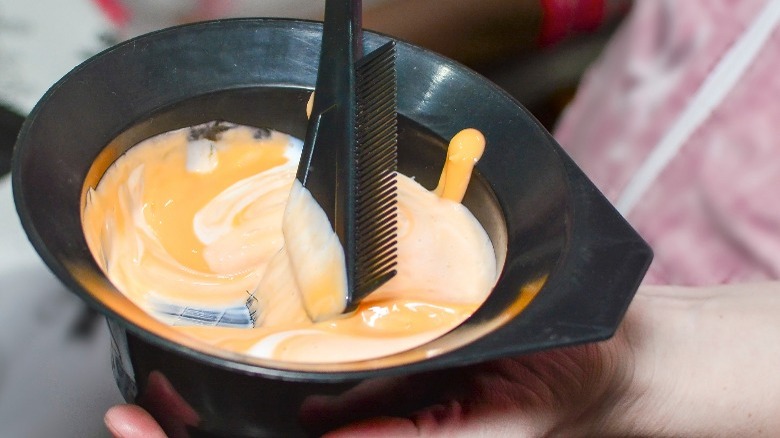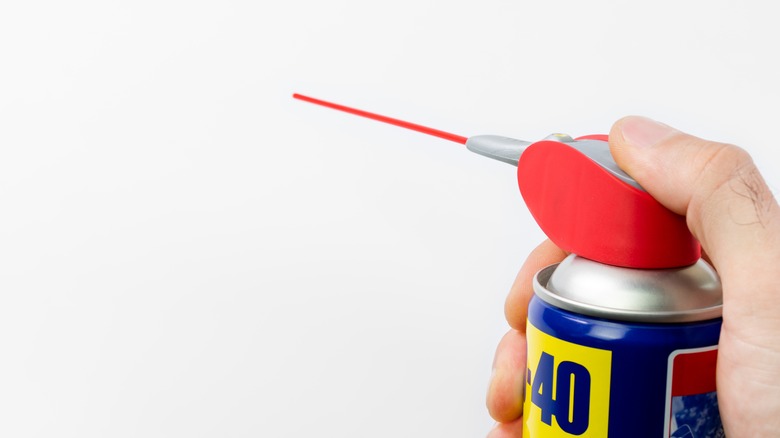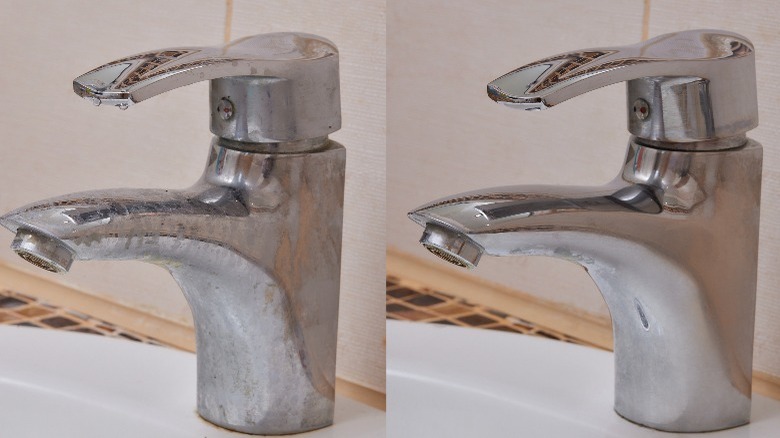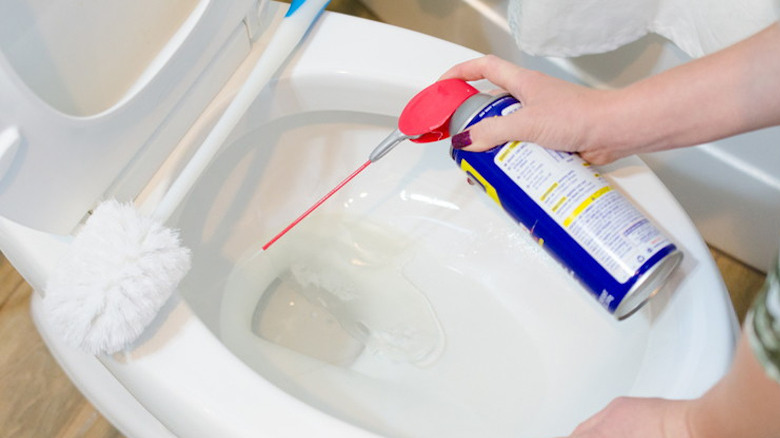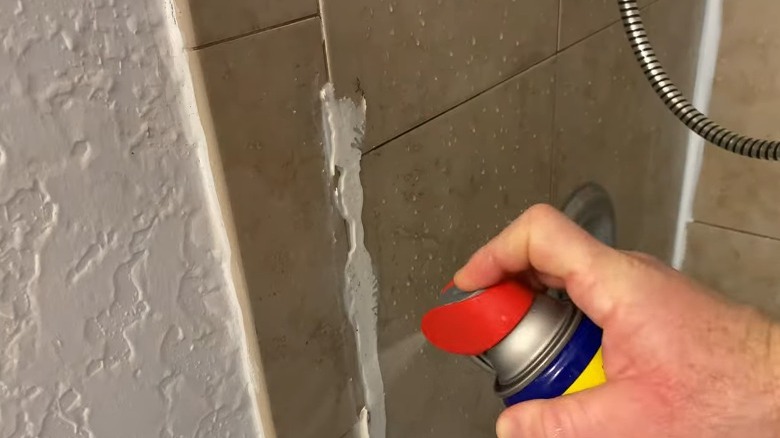Here's How To Clean Your Bathroom With WD-40
WD-40 is a time-tested, reliable household staple, but is often relegated to garages and only used for lubricating things like wheels and hinges. But this familiar blue and yellow can holds an incredibly versatile product that cleans practically anything — specifically in bathrooms. This information is good to know, because this part of the house can get quite dirty.
The letters WD stand for "water displacement," and the number represents how many tries it took to reach the final formula. Originally designed for rust prevention, WD-40 contains petroleum base oil, aliphatic hydrocarbon, and carbon dioxide. This product is also 50% mineral spirits, a solvent mixture made from petroleum compounds that has many uses, including the capability of cleaning a variety of different things.
The ingredients are flammable, so WD-40 should be kept away from hot surfaces, flames, and heat. Never smoke while using it and don't store the containers in sunny areas. It's not necessary to wear a respirator, but put on gloves, always spray away from your face, and use a mask if the smell is irritating. WD-40 cleans and also prevents and removes limescale and rust, so it has quite a few applications in bathrooms and can cut down on cleaning time. Here are some ways to use it.
Remove stains from bathroom counters and tubs
People who are in the daily habit of bringing their morning coffee and tea into the bathroom appreciate the convenience of having their drinks nearby, but usually end up having to deal with the unsightly brown rings that get left behind. When noticed immediately, these discolorations can usually be swiped away quickly with a cleaner, but when missed or forgotten, they can be much more stubborn.
Removing those rings with WD-40 doesn't take long at all and works surprisingly well — just add a bit of it to the marks and wait a few minutes. Then, simply wipe with a damp sponge or cloth and the counter will look like new. And for those who enjoy a glass of wine while taking a bath or a can of soda while drying their hair, WD-40 works just as well on those kinds of stains, too.
Eliminate water stains from glass
Hard water leaves an annoying chalky-looking residue on bathroom surfaces and can be especially noticeable on glass shower doors. That's because it has high concentrations of minerals, and once the liquid evaporates, those whitish particles remain on the surfaces. It's mostly made up of calcium, magnesium, and lime, and the problem gets worse when it's compounded by soap scum buildup. Using a window cleaner and squeegee can help, but even the most conscientious after-shower wipe downs won't remove the persistent cloudiness that keeps accumulating.
To remove hard water stains and soap scum film on a glass shower, spray the entire surface at once (we recommend wearing non-slip shoes, as WD-40 contains oil and the floor could get slippery). Give it from 15 to 30 minutes to work, and then wipe it away with clean microfiber towels. WD-40's water-displacement properties will also help to prevent future residue from accumulating.
Clean cement tile grout
Cement tile grout can get much dirtier than epoxy grout because it is porous. It does not stand up well to chemicals and liquids, and this means that things like oily personal care products and dirt can get absorbed into it and leave thick, hard-to-remove globs and discolorations. Epoxy grout can be cleaned easily, but when the joints are filled with cement grout, the stains can appear more readily and are visible on tiled bathroom floors and walls. This makes them look old and dingy before their time.
Tile grout can be cleaned with WD-40 and the cans with the slim straw nozzles are best for getting into the narrow grooves. Aim it at the grime and let it sit there for a few minutes before rinsing it with soap and water. WD-40 does not specifically recommend using the product to remove mold, but a coating can help it from coming back after the mildew is initially removed with a product designed for this purpose.
Remove scuff marks from bathroom floors
Shoes that have dark black or dark brown rubber heels are prone to leaving scuff marks on bathroom floors and this is particularly noticeable on light-colored ones. The marks are oil-based and products like store-bought floor cleaners and strippers can actually make them worse. Scuff marks are typically not made up of organic materials, and that's what many of those cleaners are formulated to tackle. And while a floor stripper can eliminate scuff marks, it could also take up some of the floor's finish with it.
The WD-40 scuff-removal method works best on tile and vinyl bathroom floors (remember to wear your non-slip shoes to prevent accidents!) Spray on the WD-40, wait just a couple of seconds, and wipe it away with paper towels. Don't rub too aggressively and use a circular motion to loosen up the marks. And remember to fully clean the oily residue when finished.
Get stains out of bathroom mats and runners
Bathroom mats and runners provide soft surfaces, in addition to non-slip bottoms that prevent slips and falls, so they're usually placed on the ground in front of showers, tubs, and sinks. They can be made out of memory foam, chenille, cotton, and other materials, but ones with rubber or latex backing can't always be put in the washing machine. That makes stain removal a bit more challenging.
WD-40 can tackle tough bathroom mat and runner stains because the mineral oil it contains acts as a solvent cleansing agent. This means that it breaks down oily stains in fabrics and can be used to pretreat them on these bathroom accessories. Spray it on, wait five minutes, and wash it in the machine if the label says that is safe. Otherwise, clean it by hand after pre-treating it with a heavy-duty detergent and rinsing it with water when finished.
Get rid of hair dye stains
Hair stylists know to protect customers and surfaces when using dyes, but people who use these coloring products at home aren't always as careful, and not taking proper precautions — like covering up the countertop with old towels — can lead to unwanted dye splatters. The messy stuff can also fly onto walls, bathroom curtains, and anywhere else in the room, and they can seem impossible to remove. The dyes contain color pigments that change hair color, so it's no wonder why they can be so stubborn — especially once they have dried.
The chemicals in WD-40 will also dissolve hair dye stains on bathroom surfaces. Just spray and wipe. And if the dye gets onto bathroom towels, rub some of it into those stains as well. Then, they can get tossed into the washer and cleaned on the hottest cycle. The same method can be used to remove bathroom stains from washable curtains in the room.
Brighten up faded plastic
Bathrooms can have a good amount of plastic in them, whether it be a toilet seat cover, a toilet brush, or plastic trim. Over time, these things can fade to the point it seems like the only option is to buy new ones. But with a little bit of WD-40, they can be given a second chance. Homeowners often use the spray to give new life to outdoor plastic furniture, but there's no reason why it can't be used indoors in bathrooms for the same purpose.
This method is also simple — spritz it onto the plastic surface and gently scrub away until it brightens up. A word to the wise, though: WD-40 should not be used on clear polystyrene and polycarbonate plastic. If you are not sure about the type of plastic in your bathroom, test the WD-40 in a hidden area first. Give it a day or so to see if the surface is damaged in any way, and if not, go ahead and continue using it.
Shine up faucets
Formerly shiny sink and bathtub faucets can get dirty and clogged up from hard water deposits, and rust formation can also be a problem. While WD-40 lubricates and prevents rust from growing on bathroom fixtures, it can also make them nice and shiny. So squirt it a few times inside the faucet to clean out all the water deposits in there, and then rub some onto the outside to remove stains. An old toothbrush is the perfect tool for getting into the tight spots.
If the fixtures are made from chrome, add a small amount of WD-40 to a cleaning cloth and rub gently. This is safer than using an abrasive cleaner or tool since chrome is a softer kind of metal. Other products could scratch the chrome, and even though WD-40 can work magic in bathrooms, it doesn't have the ability to erase that kind of damage.
Remove toilet bowl stains
Toilets often develop discolorations in their bowls that appear as dark rings. These come from hard water, bacteria, and rust deposits, and regular toilet cleaners don't always remove them well enough. Scrubbing might work, but it can dull the shine.
WD-40 cannot be flushed down the toilet though, because it negatively impacts septic systems. The oils that attack rust and lime also kill the good bacteria those systems need and can even cause clogs. To properly use WD-40 to clean a toilet bowl, remove any water in there with a plastic bowl or cup. Shake the can and use the straw to direct it onto the ring. After a few minutes, the stain will dissolve. Wipe the mess away with a toilet brush, sponge, or cloth and check for and remove any WD-40 residue that may have gotten on other parts of the toilet. Then, it can be flushed and cleaned with a septic-safe toilet cleaning product, if needed.
Clean up caulk
It is not unusual for a shower to have hardened caulk stains on the tiles, and much of the time, people just let them be. The marks might be unappealing to look at, but aren't technically dirt or grime. But when you're deep cleaning your bathroom and want to make sure everything is perfectly pristine, WD-40 is also good for removing certain kinds of excess caulk in bathrooms.
Start by trying to remove some of the excess with a blunt-edged tool like a butter knife and then spray the area with a dose of WD-40. There's no need to coat the area thickly. Head right back in with the butter knife, and amazingly enough, the caulk will have loosened and be easy to scrape away. Spray some more on as needed and this job will get finished in no time flat. Be aware that this hack might not work on silicone caulk since WD-40 is not formulated to break that down. And depending on the type of caulk that is on the tiles, the spray might be more effective if it sits longer — it can take up to an hour.
